warning YAMAHA YZF-R6 2013 User Guide
[x] Cancel search | Manufacturer: YAMAHA, Model Year: 2013, Model line: YZF-R6, Model: YAMAHA YZF-R6 2013Pages: 110, PDF Size: 2.43 MB
Page 24 of 110

INSTRUMENT AND CONTROL FUNCTIONS
3-9
3
NOTICE
ECA10031
Do not operate the engine in the ta-
chometer red zone.
Red zone: 16500 r/min and aboveClock
To set the clock1. Turn the key to “ON”.
2. Push the “SELECT” button and“RESET” button together for at
least two seconds.
3. When the hour digits start flashing, push the “RESET” button to set the
hours.
4. Push the “SELECT” button, and the minute digits will start flashing. 5. Push the “RESET” button to set
the minutes.
6. Push the “SELECT” button and then release it to start the clock.
Odometer, tripmeter, and stopwatch
modes
Push the “SELECT” button to switch
the display between the odometer
mode “ODO”, the tripmeter modes
“TRIP A” and “TRIP B” and the stop-
watch mode in the following order:
TRIP A → TRIP B → ODO → Stop-
watch → TRIP A
If the fuel level warning light comes on
(see page 3-4), the odometer display
will automatically change to the fuel re- serve tripmeter mode “F-TRIP” and
start counting the distance traveled
from that point. In that case, push the
“SELECT” button to switch the display
between the various tripmeter, odome-
ter, and stopwatch modes in the follow-
ing order:
F-TRIP
→ Stopwatch → TRIP A →
TRIP B → ODO → F-TRIP
To reset a tripmeter, select it by push-
ing the “SELECT” button, and then
push the “RESET” button for at least
one second. If you do not reset the fuel
reserve tripmeter manually, it will reset
itself automatically and the display will
return to the prior mode after refueling
and traveling 5 km (3 mi).
Stopwatch mode
To change the display to the stopwatch
mode, select it by pushing the “SE-
LECT” button. (The stopwatch digits
will start flashing.) Release the “SE-
LECT” button, and then push it again
for a few seconds until the stopwatch
digits stop flashing.1. Clock
km/h
TRIP A
1
1. Odometer/tripmeter/fuel reserve tripme- ter/stopwatch
TRIP A
˚C
1
U1JSE1E0.book Page 9 Wednesday, June 6, 2012 10:05 AM
Page 25 of 110
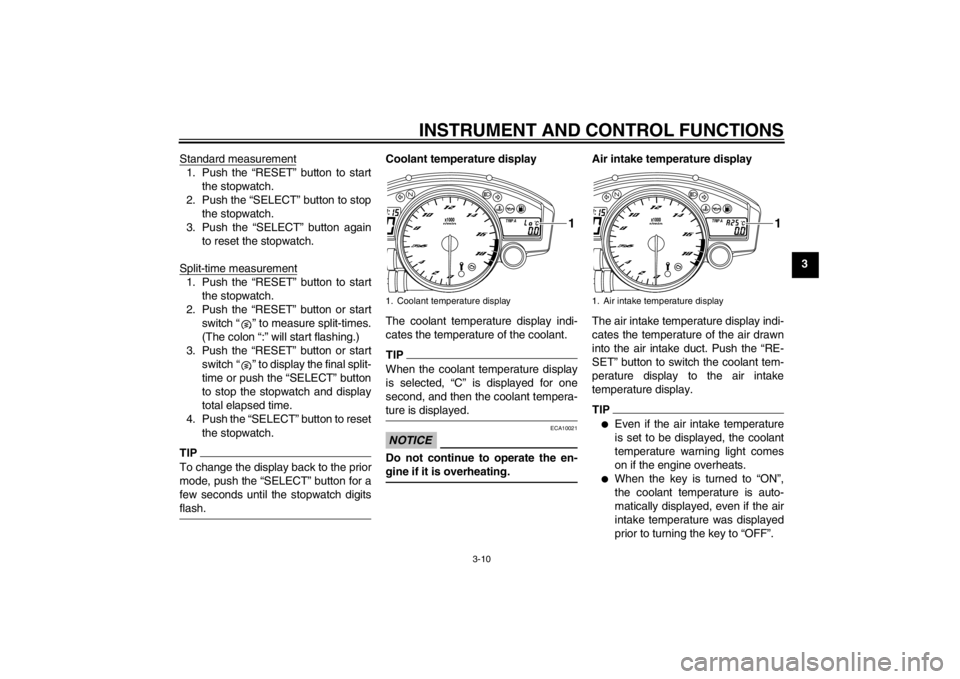
INSTRUMENT AND CONTROL FUNCTIONS
3-10
3
Standard measurement
1. Push the “RESET” button to start
the stopwatch.
2. Push the “SELECT” button to stop the stopwatch.
3. Push the “SELECT” button again to reset the stopwatch.
Split-time measurement1. Push the “RESET” button to start the stopwatch.
2. Push the “RESET” button or start switch “ ” to measure split-times.
(The colon “:” will start flashing.)
3. Push the “RESET” button or start switch “ ” to display the final split-
time or push the “SELECT” button
to stop the stopwatch and display
total elapsed time.
4. Push the “SELECT” button to reset the stopwatch.TIPTo change the display back to the prior
mode, push the “SELECT” button for a
few seconds until the stopwatch digits
flash.
Coolant temperature display
The coolant temperature display indi-
cates the temperature of the coolant.TIPWhen the coolant temperature display
is selected, “C” is displayed for one
second, and then the coolant tempera-
ture is displayed.NOTICE
ECA10021
Do not continue to operate the en-
gine if it is overheating.
Air intake temperature display
The air intake temperature display indi-
cates the temperature of the air drawn
into the air intake duct. Push the “RE-
SET” button to switch the coolant tem-
perature display to the air intake
temperature display.TIP●
Even if the air intake temperature
is set to be displayed, the coolant
temperature warning light comes
on if the engine overheats.
●
When the key is turned to “ON”,
the coolant temperature is auto-
matically displayed, even if the air
intake temperature was displayed
prior to turning the key to “OFF”.
1. Coolant temperature display
TRIP A
˚C
1
1. Air intake temperature display
TRIP A
˚C
1
U1JSE1E0.book Page 10 Wednesday, June 6, 2012 10:05 AM
Page 26 of 110

INSTRUMENT AND CONTROL FUNCTIONS
3-11
3
●
When the air intake temperature
display is selected, “A” is displayed
before the temperature.
Self-diagnosis device
This model is equipped with a self-diag-
nosis device for various electrical cir-
cuits.
If a problem is detected in any of those
circuits, the engine trouble warning light
will come on and the right display will in-
dicate an error code.
If the right display indicates any error
codes, note the code number, and then
have a Yamaha dealer check the vehi-
cle.The self-diagnosis device also detects
problems in the immobilizer system cir-
cuits.
If a problem is detected in the immobi-
lizer system circuits, the immobilizer
system indicator light will flash and the
right display will indicate an error code.
TIPIf the right display indicates error code
52, this could be caused by transpon-
der interference. If this error code ap-
pears, try the following.1. Use the code re-registering key to
start the engine.TIPMake sure there are no other immobi-
lizer keys close to the main switch, and
do not keep more than one immobilizer
key on the same key ring! Immobilizer
system keys may cause signal interfer-
ence, which may prevent the engine
from starting.2. If the engine starts, turn it off andtry starting the engine with the
standard keys. 3. If one or both of the standard keys
do not start the engine, take the
vehicle, the code re-registering
key and both standard keys to a
Yamaha dealer and have the stan-
dard keys re-registered.
NOTICE
ECA11590
If the display indicates an error
code, the vehicle should be checked
as soon as possible in order to avoid
engine damage.Display brightness and shift timing
indicator light control mode
1. Immobilizer system indicator light
2. Engine trouble warning light “ ”
3. Error code display
321
1. Shift timing indicator light activation range
2. Brightness adjustable displays
3. Brightness level display
4. Shift timing indicator light
km/h
1
2
3
4
2
U1JSE1E0.book Page 11 Wednesday, June 6, 2012 10:05 AM
Page 29 of 110
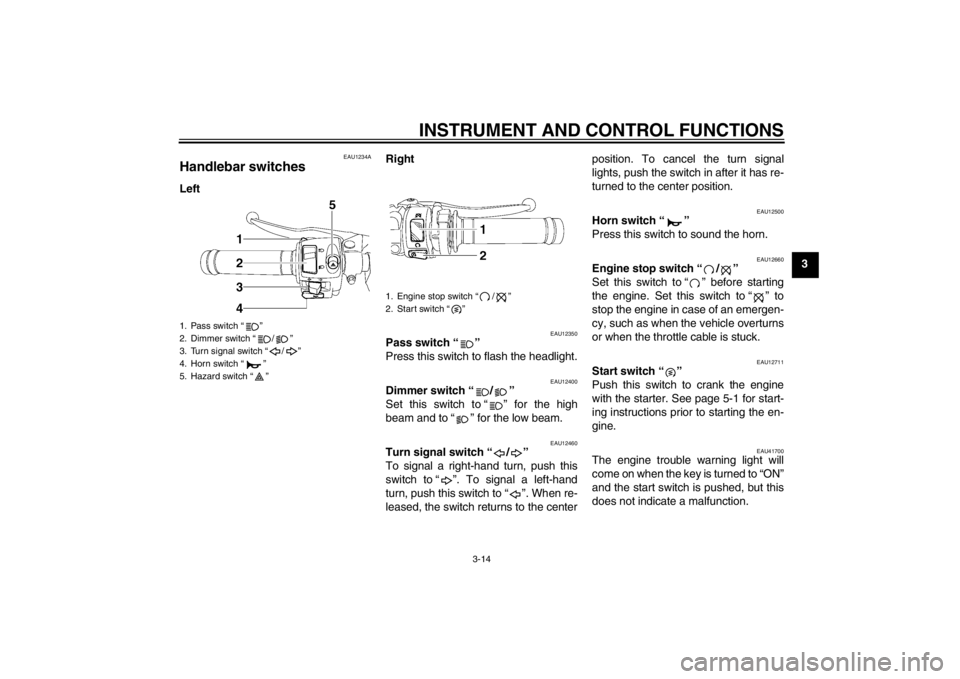
INSTRUMENT AND CONTROL FUNCTIONS
3-14
3
EAU1234A
Handlebar switches LeftRight
EAU12350
Pass switch “ ”
Press this switch to flash the headlight.
EAU12400
Dimmer switch “ / ”
Set this switch to “ ” for the high
beam and to “ ” for the low beam.
EAU12460
Turn signal switch “ / ”
To signal a right-hand turn, push this
switch to “ ”. To signal a left-hand
turn, push this switch to “ ”. When re-
leased, the switch returns to the center position. To cancel the turn signal
lights, push the switch in after it has re-
turned to the center position.
EAU12500
Horn switch “ ”
Press this switch to sound the horn.
EAU12660
Engine stop switch “ / ”
Set this switch to “ ” before starting
the engine. Set this switch to “ ” to
stop the engine in case of an emergen-
cy, such as when the vehicle overturns
or when the throttle cable is stuck.
EAU12711
Start switch “ ”
Push this switch to crank the engine
with the starter. See page 5-1 for start-
ing instructions prior to starting the en-
gine.
EAU41700
The engine trouble warning light will
come on when the key is turned to “ON”
and the start switch is pushed, but this
does not indicate a malfunction.
1. Pass switch “ ”
2. Dimmer switch “ / ”
3. Turn signal switch “ / ”
4. Horn switch “ ”
5. Hazard switch “ ”
1. Engine stop switch “ / ”
2. Start switch “ ”
U1JSE1E0. book Page 14 Wednesday , June 6, 2012 10: 05 A M
Page 32 of 110
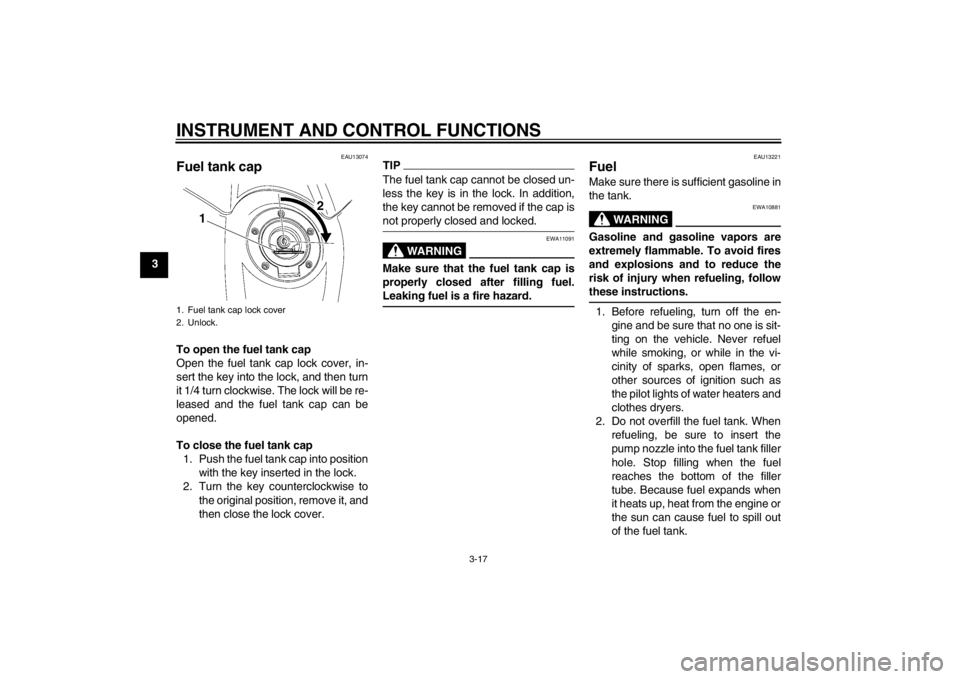
INSTRUMENT AND CONTROL FUNCTIONS
3-17
3
EAU13074
Fuel tank cap To open the fuel tank cap
Open the fuel tank cap lock cover, in-
sert the key into the lock, and then turn
it 1/4 turn clockwise. The lock will be re-
leased and the fuel tank cap can be
opened.
To close the fuel tank cap1. Push the fuel tank cap into position with the key inserted in the lock.
2. Turn the key counterclockwise to the original position, remove it, and
then close the lock cover.
TIPThe fuel tank cap cannot be closed un-
less the key is in the lock. In addition,
the key cannot be removed if the cap is
not properly closed and locked.
WARNING
EWA11091
Make sure that the fuel tank cap is
properly closed after filling fuel.
Leaking fuel is a fire hazard.
EAU13221
Fuel Make sure there is sufficient gasoline in
the tank.
WARNING
EWA10881
Gasoline and gasoline vapors are
extremely flammable. To avoid fires
and explosions and to reduce the
risk of injury when refueling, follow
these instructions.1. Before refueling, turn off the en-gine and be sure that no one is sit-
ting on the vehicle. Never refuel
while smoking, or while in the vi-
cinity of sparks, open flames, or
other sources of ignition such as
the pilot lights of water heaters and
clothes dryers.
2. Do not overfill the fuel tank. When refueling, be sure to insert the
pump nozzle into the fuel tank filler
hole. Stop filling when the fuel
reaches the bottom of the filler
tube. Because fuel expands when
it heats up, heat from the engine or
the sun can cause fuel to spill out
of the fuel tank.
1. Fuel tank cap lock cover
2. Unlock.
1 2
U1JSE1E0.book Page 17 Wednesday, June 6, 2012 10:05 AM
Page 33 of 110
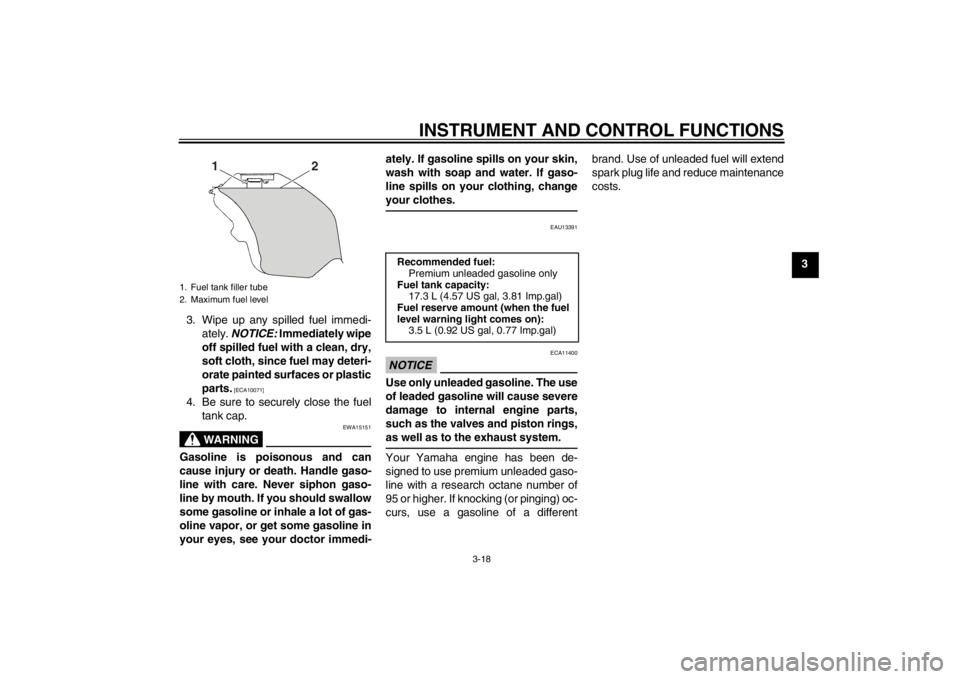
INSTRUMENT AND CONTROL FUNCTIONS
3-18
3
3. Wipe up any spilled fuel immedi- ately. NOTICE: Immediately wipe
off spilled fuel with a clean, dry,
soft cloth, since fuel may deteri-
orate painted surfaces or plastic
parts.
[ECA10071]
4. Be sure to securely close the fuel tank cap.
WARNING
EWA15151
Gasoline is poisonous and can
cause injury or death. Handle gaso-
line with care. Never siphon gaso-
line by mouth. If you should swallow
some gasoline or inhale a lot of gas-
oline vapor, or get some gasoline in
your eyes, see your doctor immedi- ately. If gasoline spills on your skin,
wash with soap and water. If gaso-
line spills on your clothing, change
your clothes.
EAU13391
NOTICE
ECA11400
Use only unleaded gasoline. The use
of leaded gasoline will cause severe
damage to internal engine parts,
such as the valves and piston rings,
as well as to the exhaust system.Your Yamaha engine has been de-
signed to use premium unleaded gaso-
line with a research octane number of
95 or higher. If knocking (or pinging) oc-
curs, use a gasoline of a different
brand. Use of unleaded fuel will extend
spark plug life and reduce maintenance
costs.
1. Fuel tank filler tube
2. Maximum fuel level
2
1
Recommended fuel:
Premium unleaded gasoline only
Fuel tank capacity: 17.3 L (4.57 US gal, 3.81 Imp.gal)
Fuel reserve amount (when the fuel
level warning light comes on): 3.5 L (0.92 US gal, 0.77 Imp.gal)
U1JSE1E0.book Page 18 Wednesday, June 6, 2012 10:05 AM
Page 34 of 110
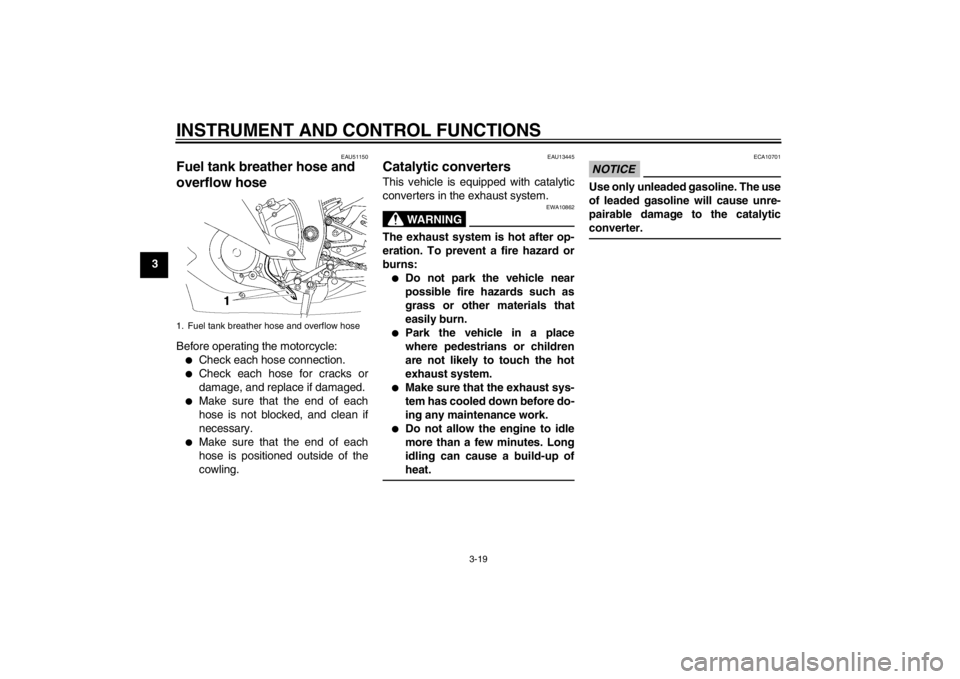
INSTRUMENT AND CONTROL FUNCTIONS
3-19
3
EAU51150
Fuel tank breather hose and
overflow hose Before operating the motorcycle:●
Check each hose connection.
●
Check each hose for cracks or
damage, and replace if damaged.
●
Make sure that the end of each
hose is not blocked, and clean if
necessary.
●
Make sure that the end of each
hose is positioned outside of the
cowling.
EAU13445
Catalytic converters This vehicle is equipped with catalytic
converters in the exhaust system.
WARNING
EWA10862
The exhaust system is hot after op-
eration. To prevent a fire hazard or
burns:●
Do not park the vehicle near
possible fire hazards such as
grass or other materials that
easily burn.
●
Park the vehicle in a place
where pedestrians or children
are not likely to touch the hot
exhaust system.
●
Make sure that the exhaust sys-
tem has cooled down before do-
ing any maintenance work.
●
Do not allow the engine to idle
more than a few minutes. Long
idling can cause a build-up of
heat.
NOTICE
ECA10701
Use only unleaded gasoline. The use
of leaded gasoline will cause unre-
pairable damage to the catalytic
converter.
1. Fuel tank breather hose and overflow hoseU1JSE1E0.book Page 19 Wednesday, June 6, 2012 10:05 AM
Page 36 of 110
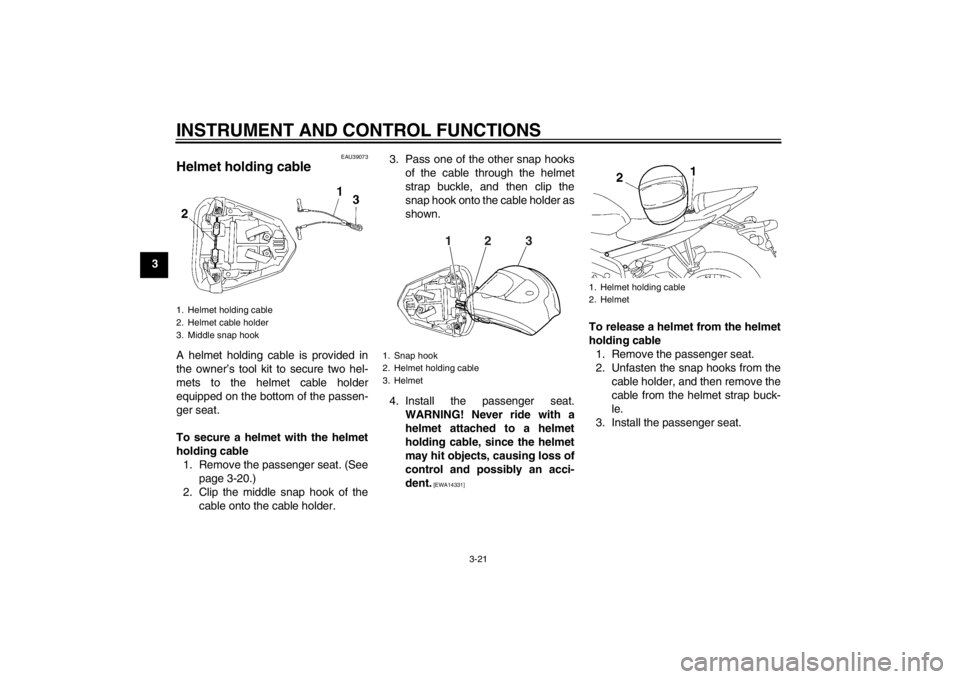
INSTRUMENT AND CONTROL FUNCTIONS
3-21
3
EAU39073
Helmet holding cable A helmet holding cable is provided in
the owner’s tool kit to secure two hel-
mets to the helmet cable holder
equipped on the bottom of the passen-
ger seat.
To secure a helmet with the helmet
holding cable1. Remove the passenger seat. (See page 3-20.)
2. Clip the middle snap hook of the cable onto the cable holder. 3. Pass one of the other snap hooks
of the cable through the helmet
strap buckle, and then clip the
snap hook onto the cable holder as
shown.
4. Install the passenger seat. WARNING! Never ride with a
helmet attached to a helmet
holding cable, since the helmet
may hit objects, causing loss of
control and possibly an acci-
dent.
[EWA14331]
To release a helmet from the helmet
holding cable1. Remove the passenger seat.
2. Unfasten the snap hooks from the cable holder, and then remove the
cable from the helmet strap buck-
le.
3. Install the passenger seat.
1. Helmet holding cable
2. Helmet cable holder
3. Middle snap hook
1. Snap hook
2. Helmet holding cable
3. Helmet
1
2
3
1. Helmet holding cable
2. Helmet
U1JSE1E0.book Page 21 Wednesday, June 6, 2012 10:05 AM
Page 37 of 110

INSTRUMENT AND CONTROL FUNCTIONS
3-22
3
EAU39671
Rear view mirrors The rear view mirrors of this vehicle can
be folded forward or backward for park-
ing in narrow spaces. Fold the mirrors
back to their original position before
riding.
WARNING
EWA14371
Be sure to fold the rear view mirrors
back to their original position before
riding.
EAU38945
Adjusting the front fork
WARNING
EWA10180
Always adjust both fork legs equal-
ly, otherwise poor handling and loss
of stability may result.This front fork is equipped with spring
preload adjusting bolts, rebound damp-
ing force adjusting screws, compres-
sion damping force adjusting bolts (for
fast compression damping) and com-
pression damping force adjusting bolts
(for slow compression damping).NOTICE
ECA10101
To avoid damaging the mechanism,
do not attempt to turn beyond the
maximum or minimum settings.Spring preload
To increase the spring preload and
thereby harden the suspension, turn
the adjusting bolt on each fork leg in di-
rection (a). To decrease the spring pre-
load and thereby soften the
suspension, turn the adjusting bolt on
each fork leg in direction (b).Align the appropriate groove on the ad-
justing mechanism with the top of the
front fork collar.
1. Riding position
2. Parking position
2
2
1
2
2
1
1. Spring preload adjusting bolt
1. Current setting
2. Front fork collar
1
1
(a) (b)
U1JSE1E0.book Page 22 Wednesday, June 6, 2012 10:05 AM
Page 41 of 110
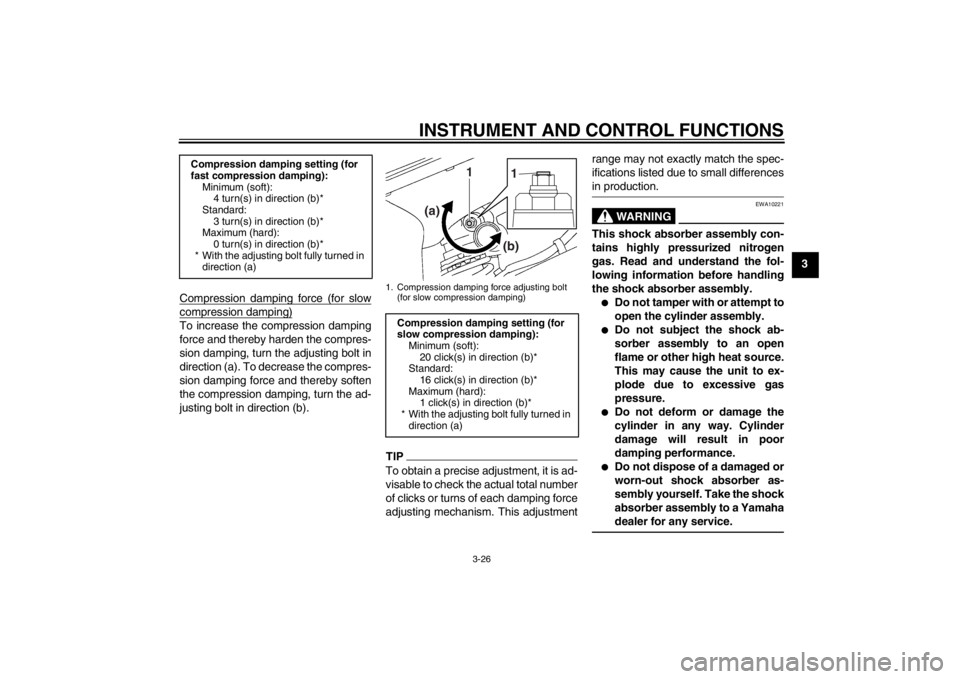
INSTRUMENT AND CONTROL FUNCTIONS
3-26
3
Compression damping force (for slow
compression damping)To increase the compression damping
force and thereby harden the compres-
sion damping, turn the adjusting bolt in
direction (a). To decrease the compres-
sion damping force and thereby soften
the compression damping, turn the ad-
justing bolt in direction (b).
TIPTo obtain a precise adjustment, it is ad-
visable to check the actual total number
of clicks or turns of each damping force
adjusting mechanism. This adjustment range may not exactly match the spec-
ifications listed due to small differences
in production.
WARNING
EWA10221
This shock absorber assembly con-
tains highly pressurized nitrogen
gas. Read and understand the fol-
lowing information before handling
the shock absorber assembly.●
Do not tamper with or attempt to
open the cylinder assembly.
●
Do not subject the shock ab-
sorber assembly to an open
flame or other high heat source.
This may cause the unit to ex-
plode due to excessive gas
pressure.
●
Do not deform or damage the
cylinder in any way. Cylinder
damage will result in poor
damping performance.
●
Do not dispose of a damaged or
worn-out shock absorber as-
sembly yourself. Take the shock
absorber assembly to a Yamaha
dealer for any service.
Compression damping setting (for
fast compression damping):
Minimum (soft):4 turn(s) in direction (b)*
Standard: 3 turn(s) in direction (b)*
Maximum (hard):
0 turn(s) in direction (b)*
* With the adjusting bolt fully turned in direction (a)
1. Compression damping force adjusting bolt
(for slow compression damping)
Compression damping setting (for
slow compression damping):Minimum (soft):
20 click(s) in direction (b)*
Standard: 16 click(s) in direction (b)*
Maximum (hard): 1 click(s) in direction (b)*
* With the adjusting bolt fully turned in
direction (a)
1
1
(a)
(b)
U1JSE1E0.book Page 26 Wednesday, June 6, 2012 10:05 AM